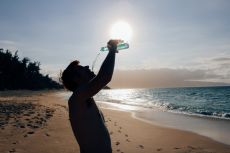The notion that wide-angle lenses can only be used for large subject matter is common, but erroneous.
Wide-angle lenses can be divided into three categories:
- standard wide-angle with focal lengths from 28 to 40 mm (film equivalent);
- super wide-angle with focal lengths from 17 to 24 mm; and
- a special type of super wide-angle: the fish-eye, which covers angles of 180 degrees and above.
Always go as close to the subject as possible to minimize the loss of colour and brilliance from absorption and diffusion in the water.
Placing the flashes
The wider angle a lens covers, the more care needs to be taken to ensure proper illumination with flash. Modern underwater strobes are capable of illuminating an angle of approximately 100 degrees, so if you use a wide-angle lense of, say, 17mm (film equivalent), which covers an angle of 105 degrees across the diagonal, dark areas will appear in the corners unless two strobes are used. To avoid backscatter from suspended particles, there needs to be a substantial distance between the flash unit(s) and the camera—about 80 cm (a little less than three feet) is good.
If you are using one flash only, it is best to position it along the camera’s vertical axis, but if you are using two, place them along the camera’s horizontal axis to ensure proper illumination of the whole image.
A good wide angle image will inevitably contain a lot of ambient light, and this must be taken into account if we want to bring out all the colours of a reef in their full splendour against a beautiful blue background.
Composing the image
Shipwrecks, landscapes or large marine animals (whales, for example) will always primarily be illuminated by ambient light, as obviously these objects are too large to light up by artificial means. In these case, flash can only be used to add touches to specific areas. It also recommended, in these cases, to shoot at an angle of 30 degrees towards the surface in order to add some perspective and depth to the image. Avoid shooting straight down.
When shooting portraits of divers in wide angle—such as a diver with fish or coral behind her—the best shooting distance is from 0.8 to 1.5 meters. In these ranges, the light of the flash will be stronger than the ambient light, so measure the background light at an angle of about 45 degrees towards the surface and set the exposure accordingly. This will produce a nice deep blue background. ...
(...)






























